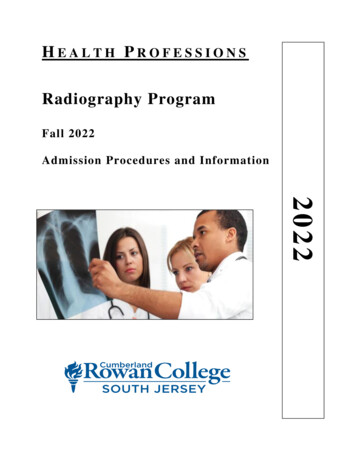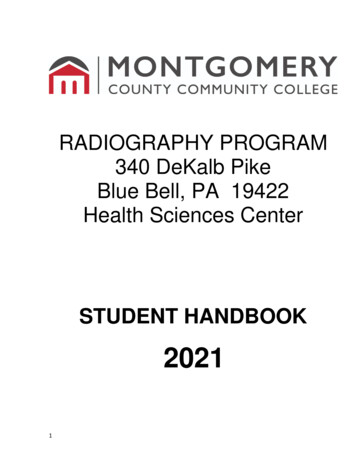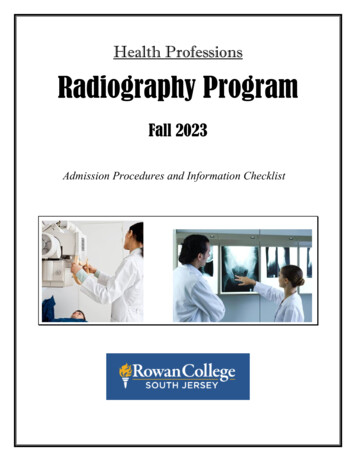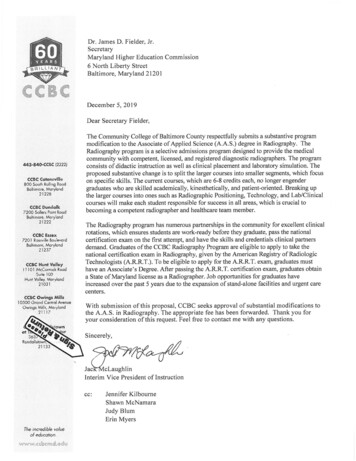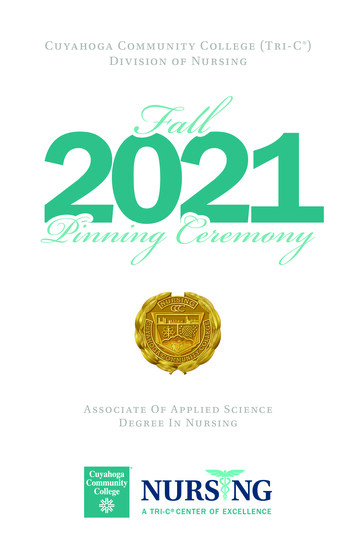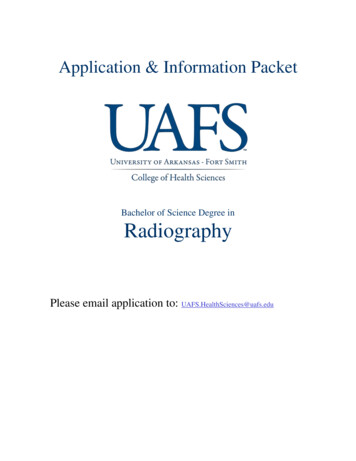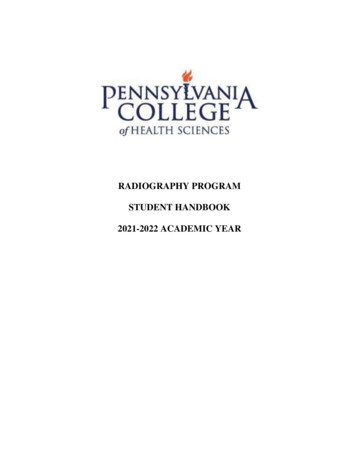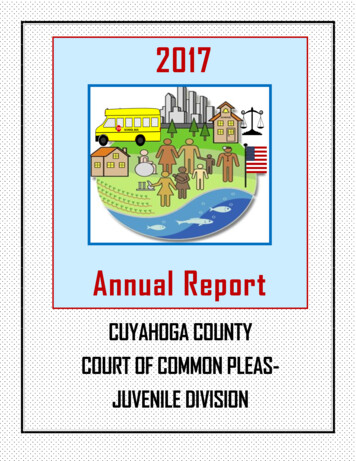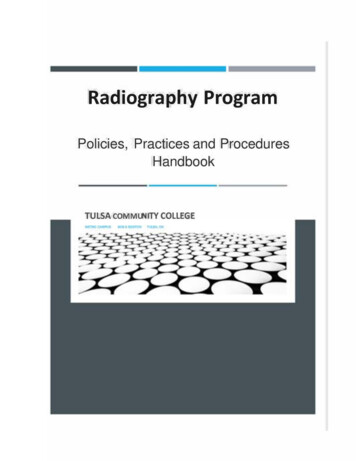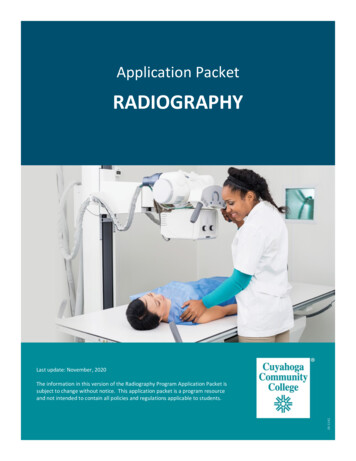
Transcription
Application PacketRADIOGRAPHYLast update: November, 2020The information in this version of the Radiography Program Application Packet issubject to change without notice. This application packet is a program resourceand not intended to contain all policies and regulations applicable to students.
Table of ContentsGENERAL INFORMATIONIntroductory Letter and Application Checklist . 2College Mission Statement . 3Radiography Program Mission Statement . 3Radiography Program Accreditation . 3Radiography Program Goals, Student Learning Outcomes and Program Effectiveness Data . 3Professional Certification and Licensure . 4Equal Opportunity Education Program . 4PROGRAM STRUCTUREProgram Track Options: Daytime and Evening/Weekend . 4Delayed Entry List (Waiting List) and Limited Enrollment Capacity . 5How to Spend Time on the Delayed Entry List (Waiting List) Wisely . 6PROGRAM EXPECTATIONS OF STUDENTSStudent Commitment . 6Essential Functions of a Radiography Student . 8Student Accessibility Services. 19Communication Skills . 10Semester Sequence . 11Additional Program Requirements. 14Program Costs . 15ADMISSION REQUIREMENTS AND PROCESSESAdmission Requirements and Processes . 15ADDITIONAL INFORMATIONFrequently Asked Questions . 18Radiography Shadowing . 20Transferring from Another Radiography Program . 21Revised November 20201
Dear Prospective Radiography Student:Thank you for your interest in the Radiography Program (“Program”). Use the application checklist belowto help you prepare for and apply to the Program.If you are not already a Tri-C student, apply to Cuyahoga Community College. See page 15.If you have not done so already, have all official high school and college/university transcripts sent toCuyahoga Community College. See page 16.Read this information packet thoroughly and view the information and videos on the Program’swebsite: www.tri-c.edu/radiography.Meet with a counselor in the Counseling Center to specify your major as radiography and create youracademic plan.Students who identify or previously identified as having a disability or who have had an individualizededucation plan/program (IEP) or 504 plan in the past should meet with Student Accessibility Servicesas soon as possible. See page 9.If you have questions that are not answered in the application packet, contact Elizabeth Gildone,Program Director, Radiography and Mammography, at (216) 987-5264.Attend a program information session as soon as possible. Attendance at a session is required priorto beginning the Program. A schedule of sessions can be found at www.tri-c.edu/radiography. Seepage 18. NOTE: This requirement has been modified due to COIVD-19 restrictions. Visitwww.tri-c.edu/radiography regularly for COVID-19 updates.Complete all Program core (prerequisite) courses, attaining cumulative and prerequisite GPA’s whichmeet the Program’s admission requirements. See page 16.Apply to the Program during the semester in which your prerequisite courses will be completed. Allprerequisite courses must be completed and cumulative/prerequisite GPA’s must be metbefore your application will be processed. An application submitted before all admissionrequirements are complete will not be processed. Use the Health Careers Application found atwww.tri-c.edu/radiography; click on “Apply to Health Careers.” Follow the submission instructions onthe application. If you meet the Program’s admission requirements, the Health Careers EnrollmentCenter will forward your application to the Program. See page 17.Watch for your acceptance email. The Program will send you an acceptance email to the emailaddress you placed on your Health Careers Application. Note that the admission process may take afew weeks. The email will contain important information and next steps. Read the emailthoroughly, print it and save it for future reference. It will contain your projected start date.Understand how the delayed entry (waiting) list works and use your time on the list to prepare forsuccess in the Program. See page 5.If you anticipate that you will not have a clear background check, now is the time to submit an EthicsReview Pre-application to the American Registry of Radiologic Technologists. See page 14.I wish you success as you prepare for the Program!Elizabeth Gildone, M.Ed., R.T. (R) (CT), GCDF, CTRProgram Director, Radiography and MammographyRevised November 20202
College Mission StatementTo provide high quality, accessible and affordable educational opportunities and services - includinguniversity transfer, technical and lifelong learning programs - that promote individual development andimprove the overall quality of life in a multicultural community.Radiography Program Mission StatementThe Radiography Program fulfills Cuyahoga Community College’s mission, vision and values within themedical imaging profession by providing high quality, accessible and affordable radiography education.The program develops technically competent, vital members of the healthcare workforce committed toexcellence in patient care, ethical behavior and lifelong learning. Furthermore, the program fostersprofessionals skilled in serving a diverse community with sensitivity and respect.Radiography Program AccreditationThe Program is accredited by the Joint Review Committee on Education in Radiologic Technology(JRCERT), 20 N. Wacker Dr., Suite 2850, Chicago, IL 60606-3182; 312-704-5300; www.jrcert.org. TheProgram complies with the JRCERT Standards for an Accredited Educational Program in RadiologicTechnology. The Standards can be viewed at www.jrcert.org.Program Goals, Student Learning Outcomes and Program Effectiveness DataIn accordance with the Joint Review Committee on Education in Radiologic Technology’s Standards for anAccredited Educational Program in Radiologic Technology, the Program measures two types of outcomes:Student Learning Outcomes (SLO’s)Program Outcomes (expressed as Program Effectiveness Data)The Program establishes goals, SLO’s and benchmarks. It utilizes a variety of tools to assess whetherSLO’s are achieved. Tools include but are not limited to student assignments, exams and laboratoryassessments, the Evaluation of Technical Skills and Professional Behavior clinical form, the ClinicalPortfolio and employer, graduate and Program exit surveys.Goal 1: Students will demonstrate clinical competenceSLO 1.1: Students will operate radiographic equipment to produce quality imagesSLO 1.2: Students will practice patient care, including radiation safety, for a diversepatient populationGoal 2: Students will demonstrate communication skillsSLO 2.1: Students will demonstrate effective interpersonal skillsSLO 2.2: Students will demonstrate effective oral and written communication skillsGoal 3: Students will demonstrate critical thinking skillsSLO 3.1: Students will demonstrate the ability to adapt to non-routine proceduresSLO 3.2: Students will relate and apply learned concepts to formulate correct responsesRevised November 20203
Goal 4: Students will demonstrate professional behaviorSLO 4.1: Students will accept personal responsibility for ethical, technical andprofessional performanceSLO 4.2: Students will demonstrate an understanding of and commitment to the medicalimaging professionProgram Outcomes (Program Effectiveness Data) include:Program Completion RateCredentialing Examination Pass RateJob Placement RateCurrent program effectiveness data can be viewed at raphy/program-effectiveness-data.html or ess-data/.Professional Certification and LicensureUpon completion of the Program, the graduate is prepared to take the national certification examinationconducted by the American Registry of Radiologic Technologists (ARRT). State of Ohio law requires allradiographers to be licensed. Radiologic licenses are obtained through the Ohio Department of Healthafter ARRT certification is obtained.Equal Opportunity Educational ProgramIn conformance with state and federal mandates, the Radiography Program at Cuyahoga CommunityCollege (“College”) is an equal opportunity educational program. The Program does not discriminate onthe basis of age (see page 18 for minimum age requirement), ancestry, color, disability, military status,national origin, race, religion, sex, sexual orientation, gender identity and expression, pregnancy, veteranstatus and genetic information. In compliance with Family Educational Rights and Privacy Act guidelines(FERPA) and in order to protect the privacy of its students, the release of information to third parties mayoccur only after receiving written permission from the student.Program Track Options: Daytime and Evening/WeekendThe Program offers both daytime and evening/weekend tracks. Both tracks are six semesters in length andinclude two summer semesters. All courses, labs and clinical requirements are the same for both tracks.Both tracks alternate academic and clinical semesters. The primary difference between the tracks lies inthe scheduling of the courses, labs and clinical hours.Daytime Track – Begins in the Fall and Spring Semesters1st, 3rd and 5th Semesters2nd, 4th, and 6th SemestersAcademic courses and labs are held at the western campus in Parma.Courses and labs are generally held between the hours of 8:00 AM and 5:00PM, Monday through FridayClinical semesters requiring 40 hours per week, Monday through Friday,at a hospital facility. Clinical hours are generally during the day withstarting times varying from approximately 7:00 to 8:00 AM. Some clinicalsites require mobile radiography rotations that may start as early as 6:00 AMduring select weeks. Other rotations include 11:30 AM to 8:00 PM andevening rotations of 2:30 to 11:00 PM. Students are not scheduled forclinicals on weekends or College-recognized holidays.Revised November 20204
Evening/Weekend Track – Begins in the Fall Semester OnlyThe evening/weekend track requires students to have significant flexibility in their schedulesbecause some daytime clinical hours are required in order to meet clinical competencyrequirements.Academic courses and labs are held Monday through Friday at the western1st Semester - Fallcampus in Parma between the hours of 5:00 and 11:00 PM. Hours may varydepending on the day and semester.Clinical hours are scheduled Monday through Friday evenings for 5 hourseach evening. Starting times are between the 4:30 and 6:00 PM and are2nd Semester - Springdependent on the clinical site. There is also an 8-hour scheduled Saturdayclinical rotation each week which may be scheduled during daytime orevening hours at the discretion of the Program and/or clinical site.In May of the first year of the Program, between the spring and summerIntersession 1 - Betweensemesters, this daytime intersession clinical requires 80 hours, Mondayspring and summerthrough Friday, over the course of two designated weeks. The total numbersemestersof clinical hours in any given week will not exceed 40.Academic courses and labs are held Monday through Friday at the western3rd Semester - Summercampus in Parma between the hours of 5:00 and 11:00 PM. Hours may varydepending on the day and semester.Clinical hours are scheduled Monday through Friday evenings for 5 hourseach evening. Starting times are between the 4:30 and 6:00 PM and are4th Semester - Falldependent on the clinical site. There is also an 8-hour scheduled Saturdayclinical rotation each week which may be scheduled during daytime orevening hours at the discretion of the Program and/or clinical site.In December and January of the second year of the Program, between theIntersession 2 - Betweenfall and spring semesters, this daytime intersession clinical requires 80fall and spring semestershours, Monday through Friday, equating to two designated weeks. The totalnumber of clinical hours in any given week will not exceed 40.Academic classes and labs are held Monday through Friday at the western5th Semester - Springcampus in Parma between the hours of 5:00 and 11:00 PM. Hours may varydepending on the day and semester.During this 10-week summer clinical semester, clinical hours are on the6th Semester - Summerdaytime shift, Monday through Friday, 40 hours per week.Delayed Entry List (Waiting List) and Limited Enrollment CapacityThe limited enrollment capacity of the Program, like other health career programs at Cuyahoga CommunityCollege, means that not all students who apply and are accepted can begin the Program immediately. Thisresults in the existence of a delayed entry or “waiting” list. The number of students accepted into theProgram is determined by a number of factors, the primary one being the availability of space in theProgram's clinical sites. It is likely that there may be some qualified applicants who cannot beaccommodated by the Program immediately. These applicants will be accepted, placed on the delayedentry list and given a projected start date. The Program website indicates the semester for which theProgram is accepting applicants based on the length of its delayed entry list. The Program does notmaintain separate delayed entry lists for the daytime and evening/weekend tracks of the Program.Students are not placed on the delayed entry (waiting) list until all admission requirements are metand the student formally applies to and is accepted into the Program.The average length of time a student is on the delayed entry list is approximately one year. Whilethere is no guarantee, it is possible that students may be contacted by the Program prior to theirprojected start date to inquire if they would be able to begin the Program sooner. This occurs whenstudents ahead of them on the delayed entry list choose not to pursue the Program.Revised November 20205
Students are contacted in the order in which they were placed on the delayed entry list. While a studentmay be contacted about an earlier start date, the student is under no obligation to begin the Program earlierthan their original projected start date. Additionally, acceptance into radiography academic courses doesnot guarantee immediate clinical placement due to variables affecting clinical site capacity which areoutside the control of the Program.How to Spend Time on the Delayed Entry List (Waiting List) WiselyStudents on the delayed entry list are encouraged to:1. Complete remaining associate of applied science (AAS) degree requirements. See the CollegeCatalog or meet with a counselor in the Counseling Office for a list of AAS degree requirements.Note that degree requirements may change over time and are determined by the semester in whicha student begins the Program. BIO 2200 (Radiobiology) and PHYS 2250 (Radiographic Physicsand Quality Control) may NOT be taken prior to beginning the Program; they must be takenconcurrently with designated radiography courses in specific semesters.2. Prepare now for success in the Program. Strong note taking, test taking and study skills areessential. The following are highly recommended:a) GEN-1022, Strategies for Success (3 credits).b) Tri-C students have 24/7 access to Student Lingo, a free, online student success resource.There are nearly 50 brief modules containing excellent success strategies. Some aredesigned for specific students, such as first-generation college students, recent high schoolgraduates and students with test anxiety. Visit www.studentlingo.com/tri-c.c) The Counseling Center offers web-based and in-person student success workshops. nt-success-workshops.html for a schedule ofofferings.3. Read Becoming a Radiologic Technologist by Jeremy Enfinger, R.T. (R). This short, inexpensivebook contains a wealth of advice and information. It is available for loan through the westerncampus library or for purchase through Amazon.com in hard copy and e-book editions. It is a mustread for prospective radiography students.4. Pursue short-term certificate programs or other experiences that will complement their radiographytraining and enhance their professional preparation (e.g. Phlebotomy Short-Term Certificate[www.tri-c.edu/phlebotomy], the Leadership Certification Program through the Office of Student l]).Contact the programs directly for information.5. Obtain volunteer experience in a hospital if they do not already have exposure to the healthcareenvironment. Contact the hospital’s volunteer department directly to explore these opportunities.6. Adjust their employment and personal commitments with the understanding that once they enter theProgram, they will be committed to a full-time program (in terms of time commitment) that issignificantly more challenging than what they experienced when completing their core courses.7. Take courses which will apply to a bachelor degree. If a student receives financial aid, thisoption should first be discussed with the Office of Financial Aid to determine if/how astudent’s financial aid award may be affected.Student CommitmentThe Program is a very rigorous and comprehensive combination of academic course work, labpractice/competency demonstration and clinical training. Radiography students express that theamount and level of work required in the Program is significantly greater than what was requiredwhile taking prerequisite coursework. Students should keep these points in mind:Revised November 20206
1. Students must achieve a minimum of a 'C' grade in all Program coursework. Courses in which a 'D'or 'F' grade is earned may result in Program academic probation and/or dismissal from the Programin accordance with the Program’s academic policies. The Program’s grading scale is below.%93 up to 10085 up to 92.9975 up to 84.9970 up to 74.99Below 70GradeABCDF2. The Program's attendance and tardiness requirements for classes, labs and clinicals are stringentand are designed to prepare students for the expectations of healthcare employers. Repeatedabsences and/or tardiness will result in point deductions that can affect course grades. Excessiveabsences and/or tardiness can result in suspension and/or dismissal from the program.3. While enrolled in the academic semesters, students are required to attend lectures, labs andadditional practice lab sessions. Regular attendance, study and active participation in allaspects of didactic coursework are critical to the student's retention of information andacademic success. A general rule of thumb is that for every hour spent in the classroom orlab, a student should expect to engage in at least two hours of study time. If one’s scheduledoes not permit this level of commitment, it is important to reconsider the feasibility ofpursuing the Program.4. While enrolled in clinical semesters, students are assigned rotations at one of the Program'sclinical sites. Students attend clinicals 40 hours per week (33 hours/week for evening/weekendtrack students); therefore, full-time employment is strongly discouraged and can significantlyimpact a student’s ability to succeed in the Program. Employment must be scheduled so as notto interfere with class, lab and clinical hours. Class, lab and clinical hours will not be adjustedto accommodate a student’s employment/personal schedule. Flexibility in one’s schedule isessential and having a strong personal support system is very important.5. The Program requires participation in occasional meetings outside of a student’s class/lab/clinicalschedule. Examples include orientation sessions and clinical assignment meetings.6. Students must adhere to a Program calendar which is provided at the beginning of the Program.The calendar details each semester including semester begin/end dates, breaks, etc.7. Clinical rotation schedules will be provided to students in advance to allow for planningemployment and personal schedules.8. The Program assigns students to clinical sites and cannot guarantee assignment to any particularsite. Students must have reliable transportation and must be willing to commute to new orunfamiliar locations. The Program’s clinical sites include*:Akron General, AkronAkron General Health and Wellness Centers in Bath, Green and StowCleveland Clinic, ClevelandCleveland Clinic Family Health Centers in Beachwood, Independence, Strongsville and TwinsburgFairview Hospital, ClevelandMarymount Hospital, Garfield HeightsMedina Hospital, MedinaMetroHealth Medical Center, ClevelandNorthern Ohio Medical Specialists – Southwest Orthopaedics, Parma and Middleburg HeightsSouthwest General Health Center, Middleburg HeightsSt. Vincent Charity Medical Center, ClevelandUniversity Hospitals Cleveland Medical Center, ClevelandRevised November 20207
University Hospitals Parma Medical Center, Parma*Clinical sites are subject to change.9. Students must understand that they will be required to engage in direct physical contact withclassmates in labs and with patients in the clinical setting. The physical contact is within the scopeof practice of a radiographer (e.g. patient transfers, patient positioning for radiographic exams, etc.)and must be done regardless of age, ancestry, color, disability, military status, national origin, race,religion, sex, sexual orientation, gender identity and expression, pregnancy, veteran status andgenetic information.10. A student’s physical appearance must convey professionalism and competence. The healthcareenvironment demands certain standards of appearance which may require students to set asidetheir personal styles and preferences in the lab and clinical setting in order to comply withprofessional and safety standards. Students will be required to follow the dress code establishedby the assigned clinical site while in their clinical rotations. The Program’s dress code is as follows:a) Tattoos must be covered by the uniform or other acceptable coverings (e.g. arm “sleeves”)b) Hair, including facial hair, must be kept clean, odor-free and well-groomed. Long hair (definedas past shirt collar) must be tied back. Hair must be of a “natural” color. “Fashion” colorsincluding but not limited to blue, pink, purple, green, etc. are not permitted.c) Glitter and excessive make-up are prohibited.d) Fingernails must be kept short (1/8 inch or shorter). Nail polish shall be a solid, light, singlecolor in keeping with a professional image. Colors such as blue, orange, green, purple or blackare not considered appropriate for creating a professional image. No artificial nails of any sortare permitted; they harbor bacteria and violate hospital infection control policy.e) Shirts worn under scrubs must be of a solid color, preferably white, and must comply with theclinical site’s dress code.f)Undergarments must not be visible beneath the uniform.g) Gum chewing is prohibited.h) Visible body piercing, including nose, tongue and mouth piercing, is prohibited.i)Excessive and/or dangling jewelry is prohibited. Earrings should be of the “post” style.j)Perfume, cologne, scented lotions and the odor of cigarette smoke are prohibited.k) Shoes must be solid white. If the clinical site dress code permits another solid color shoe (e.g.black), students may wear that color of shoe. Colored shoelaces are not permitted.l)Mobile communication devices (e.g. cell phones, Apple watches, etc.) must be kept in a lockerduring clinicals. Students may not carry them on their person.Essential Functions of a Radiography StudentBelow is a list of the essential functions for entrance into and progression through the Program. While notdefinitive, this list is meant to provide an overview of what is expected of each student. The functions areessential to support the job responsibilities of the radiologic technologist as defined in the AmericanRegistry of Radiologic Technologists’ Task Inventory for Radiography (www.arrt.org).The radiography profession requires extensive, direct patient care in a fast-paced, constantly changingclinical environment. Radiography students must be able to handle the physical, psychological andemotional demands of this type of work. Students must possess the following characteristics and abilities inorder to be successful in the Program and the profession.1. Handle the physical, psychological and emotional requirements of a radiography student.Revised November 20208
2. Demonstrate the ability to manipulate radiographic supplies and equipment and adjust theradiographic tube, which is at a height of 76 - 80 inches from the floor.3. Understand and manipulate spatial distances, spatial relationships and alignment/angulation ofimaging equipment and patient anatomy.4. Recall and perform radiographic skills in an organized, sequential manner in a timeframe deemedappropriate by the Program based on clinical parameters.5. Lift, carry and manipulate radiographic accessories and up to five imaging receptors which canweigh up to 50 pounds.6. Transfer and skillfully position patients who may weigh in excess of 300 pounds.7. Transport a mobile radiography unit for bedside radiographs.8. Give clear commands at a sufficient volume to the patient who is positioned for the radiograph at adistance 6 to 20 feet from the technologist control area.9. Read and adjust the radiographic control panel, correctly position the patient and observe themfrom a distance of 6 to 20 feet.10. Hear and respond to a patient from a distance of 6 to 20 feet.11. Must not be highly allergic to substances found in the laboratory and/or clinical environment.12. React rapidly and appropriately in emergency situations.13. Understand and follow verbal and written instructions completely in the academic and clinicalsettings.14. Demonstrate the capacity for calm and reasoned judgment in the academic and clinical settings.15. Perform in high-stress, life and death situations.16. Demonstrate professionalism, integrity and honesty in all matters.17. Demonstrate effective interpersonal communication.18. Display compassion towards all patients.Student Accessibility Services (SAS)The Americans with Disabilities Act (A.D.A.) defines a disability as any mental, physical or learningcondition that substantially limits any major life function. The A.D.A. mandates access to higher educationfor those self-identifying as disabled. Student Accessibility Services (SAS) es/index.html) supports students with disabilities at any Tri-C campus, site, location oronline course. Common disability types include learning disabilities, sensory limitations, psychiatricconditions, physical mobility conditions and chronic health issues. All matters related to a person’s disabilityare kept confidential.To receive services, students must schedule an intake appointment with a SAS advisor and providedocumentation of disability. Typical academic disability accommodations include extended time for testing,assistive hardware and software, disability advising, advocacy and referral to appropriate College programsand community agencies.Although a student’s self-identification as a person with a disability is voluntary, the Program highlyencourages students with disabilities to self-identify with SAS. This should be done well in advanceof beginning the Program. Successfully completing Program prerequisites and other college courseswithout the use of accommodations does not guarantee that they will not be needed in a rigorous healthcareer program. The Program can only accommodate known and documented disabilities following thereceipt of an accommodations memo from SAS. Each semester, the student is responsible for providingRevised November 20209
Program faculty and the Program Director with the accommodations memo given to the student by SAS.Note that due to the expediency, safety and/or technical requirements in the lab and/or clinicalenvironment, acc
The Radiography Program fulfills Cuyahoga Community College's mission, vision and values within the medical imaging profession by providing high quality, accessible and affordable radiography education. The program develops technically competent, vital members of the healthcare workforce committed to

